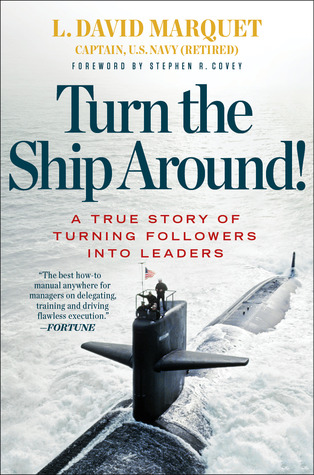More on this book
Community
Kindle Notes & Highlights
Read between
April 25 - April 26, 2022
Leadership is communicating to people their worth and potential so clearly that they are inspired to see it in themselves.
in a leader-follower structure, the performance of the organization is closely linked to the ability of the leader.
Control, we discovered, only works with a competent workforce that understands the organization’s purpose.
Mechanism: Achieve Excellence, Don’t Just Avoid Errors
I’ve organized the mechanisms into three groups: control, competence, and clarity.
Mechanism: Find the Genetic Code for Control and Rewrite It
FIND THE GENETIC CODE AND REWRITE IT is a mechanism for CONTROL.
The first step in changing the genetic code of any organization or system is delegating control, or decision-making authority, as much as is comfortable, and then adding a pinch more.
My goal, professionally and personally, was to implement enduring mechanisms that would embed the goodness of the organization in the submarine’s people and practices and wouldn’t rely on my personality to make it happen.
ACTING YOUR WAY TO NEW THINKING is a mechanism for CONTROL.
Do we act first, and think later? Or do we think first, and then change our actions?
SHORT, EARLY CONVERSATIONS is a mechanism for CONTROL. It is a mechanism for control because the conversations did not consist of me telling them what to do. They were opportunities for the crew to get early feedback on how they were tackling problems.
“I INTEND TO . . .” was an incredibly powerful mechanism for CONTROL.
RESIST THE URGE TO PROVIDE SOLUTIONS is a mechanism for CONTROL.
If the decision needs to be made urgently, make it, then have the team “red-team” the decision and evaluate it. If the decision needs to be made reasonably soon, ask for team input, even briefly, then make the decision. If the decision can be delayed, then force the team to provide inputs. Do not force the team to come to consensus; that results in whitewashing differences and dissenting votes. Cherish the dissension. If everyone thinks like you, you don’t need them.
ELIMINATING TOP-DOWN MONITORING SYSTEMS is a mechanism for CONTROL.
Don’t preach and hope for ownership; implement mechanisms that actually give ownership.
THINK OUT LOUD is a mechanism for CONTROL because when I heard what my watch officers were thinking, it made it much easier for me to keep my mouth shut and let them execute their plans.
THINK OUT LOUD also works as a mechanism for ORGANIZATIONAL CLARITY.
EMBRACE THE INSPECTORS is a mechanism for CONTROL, organizational control.
mechanisms we employed to strengthen technical competence. They are: Take deliberate action. We learn (everywhere, all the time). Don’t brief, certify. Continually and consistently repeat the message. Specify goals, not methods.
Control without competence is chaos.
CONTINUALLY AND CONSISTENTLY REPEAT THE MESSAGE is a mechanism for COMPETENCE.
SPECIFYING GOALS, NOT METHODS is a mechanism for COMPETENCE.
Clarity means people at all levels of an organization clearly and completely understand what the organization is about. This is needed because people in the organization make decisions against a set of criteria that includes what the organization is trying to accomplish. If clarity of purpose is misunderstood, then the criteria by which a decision is made will be skewed, and suboptimal decisions will be made.
the mechanisms we devised to implement leader-leader practices by stressing clarity. The mechanisms described are these: Achieve excellence, don’t just avoid errors (this was introduced in chapter 7). Build trust and take care of your people. Use your legacy for inspiration. Use guiding principles for decision criteria. Use immediate recognition to reinforce desired behaviors. Begin with the end in mind. Encourage a questioning attitude over blind obedience.
BUILDING TRUST AND TAKING CARE OF YOUR PEOPLE is a mechanism for CLARITY.
Taking care of your people does not mean protecting them from the consequences of their own behavior. That’s the path to irresponsibility. What it does mean is giving them every available tool and advantage to achieve their aims in life, beyond the specifics of the job.
USE YOUR LEGACY FOR INSPIRATION is a mechanism for CLARITY.
USE GUIDING PRINCIPLES FOR DECISION CRITERIA is a mechanism for CLARITY.
USE IMMEDIATE RECOGNITION TO REINFORCE DESIRED BEHAVIORS is a mechanism for CLARITY.
BEGIN WITH THE END IN MIND is an important mechanism for ORGANIZATIONAL CLARITY.
ENCOURAGE A QUESTIONING ATTITUDE OVER BLIND OBEDIENCE is a mechanism for CLARITY.
The core of the leader-leader model is giving employees control over what they work on and how they work. It means letting them make meaningful decisions.
With emancipation we are recognizing the inherent genius, energy, and creativity in all people, and allowing those talents to emerge. We realize that we don’t have the power to give these talents to others, or “empower” them to use them, only the power to prevent them from coming out. Emancipation results when teams have been given decision-making control and have the additional characteristics of competence and clarity.


